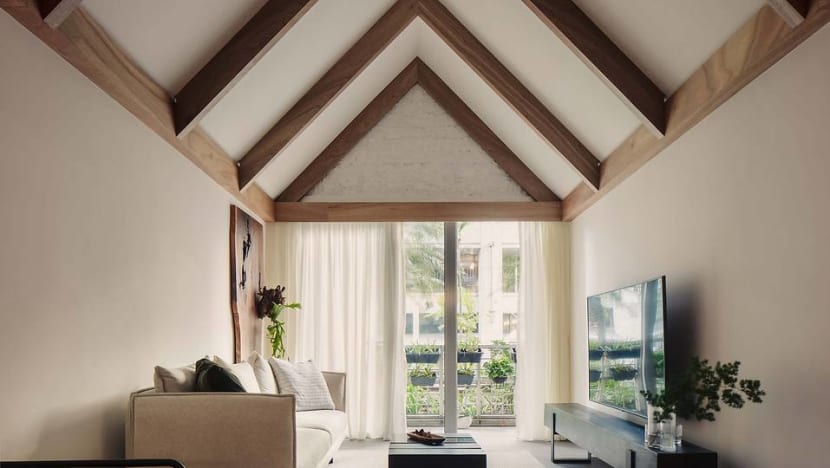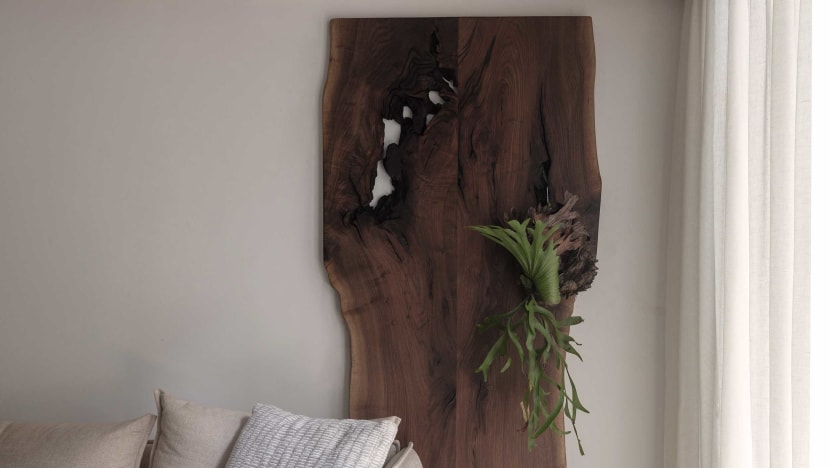House tour: An apartment in Singapore with the qualities of a landed home
A lofty, gabled ceiling makes all the difference in transforming the ambience of this two-bedroom apartment. It has become a cosy sanctuary for the homeowner, a lawyer in her 30s.

The owner of this apartment grew up in a house but subsequently moved to a flat. She missed the high ceilings and airy feel of her former dwelling. (Photo: Khoo Guo Jie)
Many Singaporeans desire to live in landed houses, drawn by the idea of sauntering in their own gardens and having ample space for various activities. But on our land-scarce island, owning such a property remains a dream for the majority of apartment dwellers.
The owner of this apartment – a lawyer in her 30s – grew up in a house but subsequently moved into a flat with her mother. “I’ve missed the high ceilings and airy feel of a landed home,” she shared.
READ> Single buyer purchases all 20 units at Orchard condo for almost S$300 million
Seven years ago, she considered moving into one but it would have been too large, and the maintenance cost too impractical, for a single occupant.
She ended up purchasing this two-bedroom, ground-level unit in UE Square Residences. As she hoped to work overseas, she rented it out. When the plan did not materialise, she made the decision to live in this apartment after the tenant’s contract ended in 2019 – though not without first remodelling it into a place she could call home.

She engaged L Architects for the project. The firm’s founder, Lim Shing Hui, was a personal friend whose work and ideas she had witnessed over the years. Lim heard about the owner’s initial idea of looking for a landed property, which seeded the unusual approach of designing the apartment as if it were a single-storey dwelling.
The 1,119 sq ft apartment’s interior was uninspiring. It had the typical, rectilinear condominium layout that prioritises function over feel. The main door opened to a narrow corridor that separated it from the kitchen, and the living and dining were an ambiguous, shared space.

But it also had positive aspects. The longish unit was elevated from the road at the street-facing side, making it quite private. The terrace looked out into a common garden with a water feature, extending the outdoors in.
Together with her project assistant Tse Lee Shing, Lim conducted two major architectural interventions that altered the spatial dynamics. She first removed the kitchen wall, turning the formerly cloistered space into an open one with light spilling in from the kitchen yard.

WATCH> Inside Sheng Siong co-founder Lim Hock Leng’s 33,700 sq ft family home
HEART OF THE HOME
The kitchen is now the home’s social heart, anchored with a sophisticated Empress Green marble kitchen counter that greets guests entering the home. The counter extends to a long dining table, topped by an organically edged timber slab. Food preparation, cooking, serving and dining becomes a seamless sequence. The owner, who enjoys gatherings with friends, can also now engage guests seated at the dining table while cooking.
The other intervention came about after Lim removed the false ceiling. She discovered a lofty soffit height of 4.5m, up from the previous 3.1m. While most view it as common sense to insert a mezzanine for more square footage, she shaped it into a pitched roof to perpetuate the idea of a landed home.

The gabled ceiling is reminiscent of rustic barns or a child’s naive drawing of a home, and gives character to the formerly generic apartment. A rhythm of timber rafters accentuates this form. Ambient illumination draws attention to them while the dearth of distracting ceiling light fixtures keeps the sculptural quality pure.
About the rafters, Lim shared: “Before the Circuit Breaker in April 2020, we had completed the design and even submitted the application to the MCST to start work. A few days later, the Circuit Breaker kicked in so it was two months before we could execute site work,” she recalled.

Lim took the time to review the design, resulting in the idea to expose the rafters. “If not for the Circuit Breaker, we might have left it out. [It would have been a pity] as it is one of the key ideas of the house’s design. It frames the ceiling really well,” she said.
The pitched ceiling and rafters across the living and dining harmonise the two areas. In between them, a row of rotating timber doors lets the owner create a more intimate dining area when closed, or accommodate larger gatherings when opened. Wind and light penetrate the gridded perforations. The simple shapes correspond with the triangulated ceiling.

WATCH> This Singapore couple built a home on ‘stilts’ to recreate a kampung feel
SIMPLICITY IS BEST
“I like to work with uncomplicated geometries because I think that even simple elements can evolve into something interesting,” said Lim. The grid pattern recurs in the bedroom on moveable side tables hung on wall hooks. The flexible design gives the owner more space on one side of the bed when hung together, and the holes facilitate cables for lamps or electronic devices.
Other small-scale designs exhibit Lim’s interest in creating holistic environments. She also designed a timber rotating latch door lock in the master bathroom like those found in older homes.

Abstract “ponds” at three thresholds – the entrance; between the living and dining; and at the bedroom door – further the idea of living in a landed house. She filled these with round river pebbles and topped them with granite stepping stones.
“The river stones are essentially an outdoor material. We thought it was an interesting idea to use them indoors for demarcating the boundaries of three little ‘houses’ (the living, dining and bedroom),” said Lim. The act of crossing these thresholds symbolises stepping “outdoors” before transitioning into another indoor space.

Throughout the home, matte grey floor tiles and light timber-laminated cabinetry that tucks away clutter is a gentle foil to the architectural accents. “Matte finishes don’t reflect as much light so they help to keep the place visually quiet and let the pitched ceiling remain the focus,” said Lim.
This serene quality suits the owner well. “Shing Hui designed so many elements of my home that embodies how I like to be – minimalist, thoughtful and [balanced],” she said. While apprehensive at first, she now appreciates Lim’s unconventional proposals, such as the gabled roof, and using Empress Green marble instead of the common grey and white variants.

Renovating a home is often tougher than a new build as it can come with surprises. Lim’s modus operandi is to come to site with an open mind and let these discoveries, such as the high ceilings, guide her.
“We have to think of another way to ‘solve the puzzle’ that we thought we had already solved. It trains me to find aesthetically pleasing solutions that are also meaningful,” she said. In another instance, she debated whether to plaster the exposed brickwork uncovered above the former false ceiling.
She decided to leave it un-plastered for memory’s sake but painted it white to continue the apartment’s calm feel. In the bedroom where she found a half-plastered wall, Lim stripped the plaster further to the level of the bed frame’s light cove for visual neatness. In retrospect, the brick texture aligns with the barn reference.
The home, christened The House Apartment, is unable to host large parties for now but is no less well used. It embodies the idea of home as sanctuary, which was emphasised during the pandemic.
Shared the owner, “Ever since I moved in, I’ve been at home most of the time – working from home, cooking and having small gatherings with friends and church mates. My home is now my safe haven and I always look forward to being at home; I’ve turned from an extrovert who is always dining outside or travelling to someone who is always home!”












